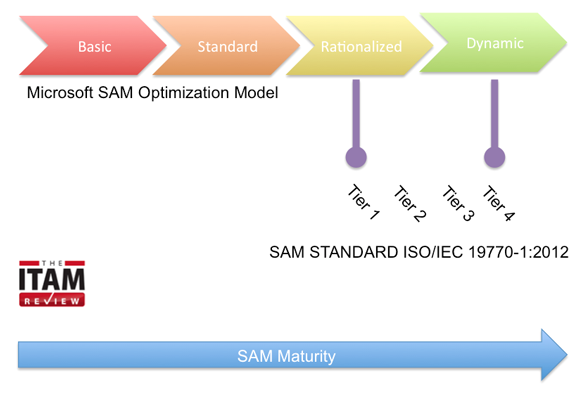Microsoft SAM Optimization Model vs. ISO/IEC 19770-1

David Bicket of M-Assure presented an update on ISO activity across the SAM Industry at the BCS SAM Networking event in London last week. One development David mentioned was a recent update to the Microsoft SAM Optimization model.
David mentioned the material had been updated by Microsoft in September to reflect the newly revised ISO SAM standard but it looks like the Microsoft website has not been updated yet. However there is a still lot of info here:
https://www.microsoft.com/sam/en/us/optmodel.aspx
The Microsoft SAM Optimization Model
“The [Microsoft] SAM Optimization model is aligned with the Infrastructure Optimization Model (IO) and provides a framework to accurately evaluate SAM processes, policies and tools”.
As with most Microsoft collateral found online, the Microsoft SOM material falls short of providing organizations with a full description of how to progress, but has been designed so that a Microsoft partner (or any other SAM partner) can guide you through the process.
Critics of the SOM model might argue that it is too basic but I believe, given the SAM maturity of most organizations today, it is a good tool for providing organizations some high level pointers.
The Optimization model assigns organizations to four levels of maturity:
- ‘Basic SAM’ – Management of software is ad-hoc and inconsistent
- ‘Standardised SAM’ – We track assets but probably don’t make best use of the data we collect
- ‘Rationalized SAM’ – We are actively managing assets throughout their lifecycle
- ‘Dynamic SAM’ – We are leveraging SAM for competitive advantage.
Or in more simple terms you might summarize the levels as:
- We’re not doing SAM
- We’ve started doing SAM
- We’re doing it properly
- We’re reaping the full benefits
The aim is to benchmark your organization against the model and identify next steps to make progress with SAM.
It should be noted that an organization might not want to progress to level 4. Just as an organization might not want to provide 99.999% availability for a service when 99.95% will do. An organization needs to judge the likely benefits versus the cost and effort involved. Similarly an organization may be at different levels of maturity for each competency.
Microsoft SOM in Practice
I used this model on a recent engagement with a client who was looking to get started with SAM. What I like most about using this model is that there are only 10 focus areas, so the client is not bombarded with SAM science, but has a concise summary of areas for improvement.
Once the organization begins to make progress, they make a judgement call as to whether they want to benchmark themselves against more sophisticated models such as the full ISO/IEC 19770-1 SAM standard.
How does the Microsoft SAM Optimization Model align to ISO/IEC 19770-1?
In a nutshell David Bicket suggested that Rationalized is ‘largely equivalent’ to Tier 1 of the SAM Standard and Dynamic is ‘largely equivalent’ to Tier 4. So it soon becomes obvious that an organization just starting out with SAM might be best to get to grips with the Microsoft SAM optimization model first (see diagram).
The Microsoft SAM Optimization model uses 10 core competencies that align themselves to ISO/IEC 19770-1
Organizational Management
- SAM throughout the organization
- SAM improvement plan
SAM Inventory Processes
- Hardware and software inventory
- Accuracy of inventory
SAM Verification
- License entitlement
- Periodic evaluation
Operational Management and Interfaces
Lifecycle process interfaces
- Acquisition Process
- Deployment Process
- Retirement Process
The result of these five ISO categories and ten competencies lead us to ten questions we can ask to evaluate SAM maturity.
In a future article we can take a look at the questions in more depth and suggested recommendations.
More info here: https://www.microsoft.com/sam/en/us/optmodel.aspx
Can’t find what you’re looking for?
More from ITAM News & Analysis
-
AI Is Here—And It’s Your Best ITAM Ally, Not Your Replacement
I’ve been asked several times over the last couple of years how AI will impact ITAM and how it will impact jobs. Well, who knows what will actually happen in the future, but my guestimate is ... -
FinOps for SaaS: A Step in the Right Direction, But Will It Work?
The FinOps Foundation is making a bold attempt to get better visibility and control of SaaS applications. This has been driven in part because the vast majority of FinOps teams also manage SaaS to some extent. ... -
The Forrester Wave SAM Solutions Report (Q1 2025)
Forrester, the US based research firm, recently released its latest SAM Solutions Wave report for Q1 2025. The report reflects its research and analysis of nine SAM providers it considers to matter the most, and scores ...
Podcast
ITAM training
Similar Posts
-
Will 'Sustainable IT' be Caught in the Crossfire?
In the days immediately following his inauguration, President Trump and his team declared war on Diversity, Equity, and Inclusion (DEI) programs at the federal level. The impact has been felt far and wide. Many government contractors ... -
Are we ready for outcome-based pricing?
When I first joined the ITAM industry (which feels like a million years ago), the predominant licensing metric in the market was per device. So, if you have three devices, you need three licenses. Then, with ... -
AI and ML: The Game Changers in ITAM for 2025
IT Asset Management (ITAM) is experiencing a groundbreaking evolution, heavily influenced by the adoption of Artificial Intelligence (AI) and Machine Learning (ML). These cutting-edge technologies will revolutionise conventional ITAM methods while bringing both exciting possibilities and ... -
Data Management Best Practices
Effective data management is crucial for successful IT asset management. Leveraging a structured approach like the PDCA (Plan-Do-Check-Act) cycle can help structure your efforts. This approach should be easy to integrate into the existing processes and/or ...




